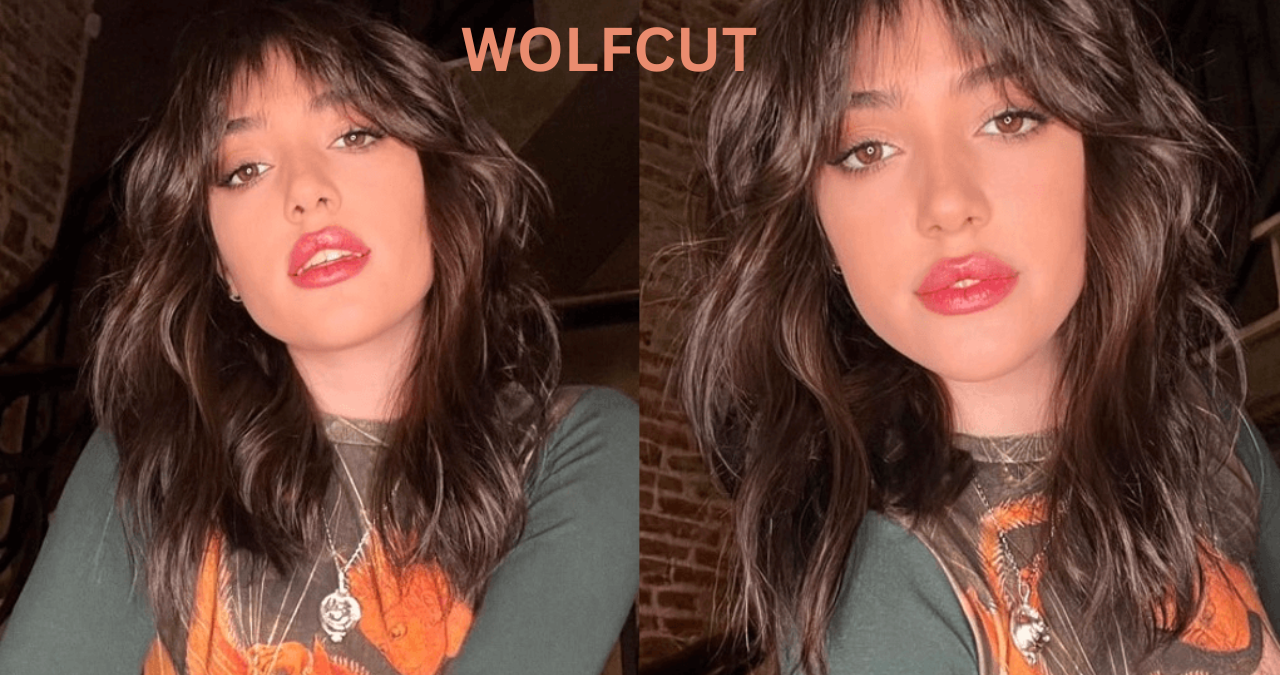Wolfcut Haircut Everything You Need to Know

The wolfcut hairstyle has taken the world by storm, becoming one of the most sought-after haircut trends of recent times. Characterized by its layered, choppy look, this style adds volume and texture to the hair, making it a favorite among many.
Originating from a blend of the mullet and shaggy hairstyles, the wolfcut is versatile and can be tailored to suit various face shapes and hair types. Its undone, effortless look is perfect for those seeking a stylish yet low-maintenance hairstyle.
As the wolfcut continues to gain popularity, it’s essential to understand its nuances and how to style it effectively. Whether you’re considering trying out this trendy haircut or simply want to learn more about it, this article will provide you with everything you need to know.
Key Takeaways
- Understanding the wolfcut hairstyle and its characteristics
- Learning how to style a wolfcut for different occasions
- Discovering the best face shapes and hair types for a wolfcut
- Exploring the history and evolution of the wolfcut
- Tips for maintaining and caring for a wolfcut hairstyle
What Is a Wolfcut Haircut?
Emerging from a mix of shaggy layers and choppy ends, the wolfcut is a modern take on classic hairstyles. This haircut has garnered significant attention for its versatility and ease of styling.
The wolfcut’s evolution is a fascinating story that reflects changing attitudes towards beauty and fashion.
Origins and Evolution of the Wolfcut
The wolfcut has its roots in the 1970s shag haircut, popularized by icons like David Bowie and Stevie Nicks. Over the years, it evolved, incorporating elements from various styles, eventually becoming the distinct look we know today.
Key milestones in the wolfcut’s evolution include:
- The 1970s shag haircut
- Influence from 80s and 90s rock music
- Modern adaptations through social media
Key Characteristics of the Wolfcut Style
The wolfcut is characterized by its choppy layers, giving it a textured, piecey look. This style works well for various hair types and can be customized to suit individual preferences.
| Characteristic | Description |
| Layering | Choppy, textured layers throughout |
| Length | Can vary from short to long |
| Style | Undone, piecey look |
The Rise of the Wolfcut in Popular Culture
The wolfcut’s rise to fame can be attributed to its adoption by celebrities and social media users alike. This hairstyle has become a sensation, with many people seeking to emulate the looks of their favorite influencers and celebrities.
Social Media Influence on the Wolfcut Trend
Social media platforms like Instagram and TikTok have played a crucial role in popularizing the wolfcut. Influencers and beauty enthusiasts share their wolfcut styles, inspiring others to try the look. The hashtag #wolfcut has gained millions of views, showcasing various interpretations of the style.
Celebrity Wolfcut Inspirations
Celebrities have also been instrumental in making the wolfcut a trend. K-pop stars and Hollywood celebrities alike have been spotted with this stylish haircut.
K-Pop Stars with Iconic Wolfcuts
K-pop idols like Blackpink’s Lisa and ITZY’s Yeji have rocked the wolfcut, influencing their fans worldwide.
Hollywood Celebrities Embracing the Wolfcut
Hollywood stars such as Emma Stone and Zendaya have also been seen sporting the wolfcut, further boosting its popularity.
Is the Wolfcut Right for You?
To know if the wolfcut is right for you, let’s examine the face shapes and hair types that complement this style.
Face Shapes That Work Best with Wolfcuts
The wolfcut can complement various face shapes, but certain shapes can pull off the look more effortlessly.
Oval and Heart-Shaped Faces
Oval faces are considered ideal for wolfcuts due to their balanced proportions. Heart-shaped faces also suit wolfcuts as the style can draw attention away from the forehead and emphasize the lower part of the face.
Square and Round Faces
Square faces can benefit from the wolfcut’s layered texture, which softens angular features. Round faces can also work with wolfcuts if the layers are styled to create the illusion of length.
| Face Shape | Wolfcut Suitability | Styling Tips |
| Oval | High | Enhance layers for added texture |
| Heart-Shaped | High | Draw attention to the lower face |
| Square | Moderate | Soften with layered texture |
| Round | Moderate | Create length with styling |
Hair Types and Textures Suited for Wolfcuts
The wolfcut is versatile and can work with different hair types, from straight to curly.
Straight Hair Wolfcuts
Straight hair can pull off a sleek wolfcut, adding volume with the right styling products.
Curly and Wavy Hair Wolfcuts
Curly and wavy hair types can enhance the wolfcut’s textured look, adding natural volume and movement.
Popular Wolfcut Variations
The wolfcut’s versatility is one of its strongest selling points, with styles available for every hair type and length. This adaptability makes it a favorite among those looking to refresh their look without committing to a completely new style.
From short and edgy to long and luscious, the wolfcut can be tailored to suit individual preferences and face shapes. Let’s explore some of the most popular wolfcut variations.
Short Wolfcut Styles
For those with shorter hair, the wolfcut can add volume and texture, creating a dynamic, piecey look. Short wolfcuts are ideal for individuals with fine hair, as they can create the illusion of thicker, fuller hair.
Medium-Length Wolfcut Options
Medium-length hair offers a lot of flexibility for wolfcut styling. This length can balance the choppy layers of a wolfcut, creating a harmonious blend of texture and flow. Medium wolfcuts are great for those who want to maintain some length while still enjoying the edgy vibe of the wolfcut.
Long Wolfcut Variations
For those with longer hair, the wolfcut can add a layer of complexity and visual interest. Long wolfcuts can be styled in numerous ways, from relaxed, effortless waves to more polished, sleek looks.
| Hair Length | Wolfcut Style | Best For |
| Short | Edgy, Piecey | Fine Hair, Heart-Shaped Faces |
| Medium | Balanced, Textured | Most Face Shapes, Versatile Styling |
| Long | Luscious, Layered | Thick Hair, Oval Faces |
How to Ask for a Wolfcut at the Salon
When you decide to get a wolfcut, knowing how to ask your stylist is crucial for achieving the desired outcome. Effective communication is key to ensuring that you leave the salon satisfied with your new look.
Key Terminology to Use with Your Stylist
To get a wolfcut that suits your style, it’s essential to use the right terminology when describing your desired look to your stylist. Terms like “layers,” “texture,” and “choppy ends” can help convey the style you’re aiming for. For instance, you might say, “I’d like a wolfcut with a lot of layering and texture, particularly around the jawline.” As celebrity stylist Chris McMillan once noted, “The key to a great wolfcut is in the layering and the texture; it’s all about creating movement.”
Reference Photos to Bring to Your Appointment
Bringing reference photos to your salon appointment can significantly help in getting the wolfcut you want. These photos serve as a visual guide for your stylist, ensuring that you’re both on the same page. You can find inspiration from celebrity styles, social media, or hair trend blogs. As Elle magazine suggests, “A good reference point can make all the difference in achieving the perfect cut.” When selecting photos, consider including images that show the wolfcut from different angles to give your stylist a comprehensive understanding of your desired style.
DIY Wolfcut: Step-by-Step Guide
With the right tools and a bit of patience, cutting your own wolfcut can be a rewarding experience. The key to a successful DIY wolfcut lies in understanding the necessary tools, preparation steps, and cutting techniques.
Tools You’ll Need
To start, gather the essential tools for cutting a wolfcut. These include:
- A comb (preferably a wide-tooth comb)
- Sharp hair scissors or hair shears
- Thinning scissors (optional)
- A mirror (ideally a tri-fold mirror for visibility)
Having the right tools will make the cutting process smoother and more precise.
Preparation Steps
Before you begin cutting, it’s crucial to prepare your hair. Start by washing and towel-drying your hair until it’s damp. Use a comb to remove any tangles or knots. It’s also helpful to have a reference picture of the wolfcut style you’re aiming for.
Cutting Technique for Beginners
The cutting technique is the most critical part of achieving a great wolfcut. Here’s a step-by-step guide:
Creating the Top Layers
Begin by sectioning your hair into layers, starting from the top. Use your comb to isolate the top section, and then cut at an angle to create layers. The angle will depend on how choppy you want your wolfcut to be.
Shaping the Bottom Layers
For the bottom layers, use a similar technique but adjust the angle according to your desired length and texture. Thinning scissors can be used to add more texture and reduce bulk.
Common DIY Mistakes to Avoid
One of the most common mistakes when cutting a wolfcut is cutting too much hair at once. To avoid this, work in small sections and check your progress frequently in the mirror. Another mistake is not using the right tools, which can lead to uneven cuts.
| Common Mistakes | How to Avoid |
| Cutting too much hair at once | Work in small sections |
| Using dull scissors | Invest in sharp hair scissors |
| Not checking progress | Use a tri-fold mirror |
By following these steps and being mindful of common mistakes, you can achieve a stylish wolfcut at home. Remember, practice makes perfect, so don’t be discouraged if it doesn’t turn out exactly as you hoped the first time.
Styling Your Wolfcut
Embracing a wolfcut means embracing a world of styling possibilities, from effortless everyday looks to glamorous special occasion styles. The key to unlocking these styles lies in understanding the versatility of your wolfcut and how to work with it.
Everyday Styling Techniques
For everyday styling, simplicity is key. You can achieve a great look with minimal effort by using the right techniques.
Air-Drying Methods
Air-drying is a great way to maintain the natural texture of your wolfcut. Use a microfiber towel or an old t-shirt to gently blot out excess moisture, and then apply a texturizing spray or sea salt spray to enhance your hair’s natural texture.
Quick Blow-Dry Techniques
For a quicker styling option, blow-drying can add volume and smoothness to your wolfcut. Use a round brush while blow-drying to lift the roots and achieve a sleek finish. Don’t forget to apply a heat protectant to prevent damage.
Special Occasion Styling Ideas
When it comes to special occasions, you can elevate your wolfcut with a few styling tricks. Consider adding some braids or twists for a more sophisticated look, or use a curling iron to create loose, glamorous waves.
- Use a styling cream or pomade to add definition and texture.
- Try a sleek updo for a more formal event.
- For a bohemian look, add some undone waves and a few loose strands framing your face.
Working with Your Natural Texture
One of the best things about a wolfcut is its ability to work with your natural texture. Whether you have straight, curly, or wavy hair, there are styling products and techniques that can enhance your natural texture.
For curly hair, use a curl activator or a light hold curl cream to define curls without weighing them down. For straight hair, consider using a volumizing mousse or root lift to add some oomph at the roots.
Essential Products for Wolfcut Maintenance
The key to a great wolfcut lies not just in the cut itself, but in the products used to style and maintain it. To keep your wolfcut looking its best, you’ll need a combination of the right shampoos, conditioners, styling products, and heat protectants.
Shampoos and Conditioners
For a wolfcut, using a gentle, sulfate-free shampoo is recommended to maintain the health and integrity of your hair. Conditioners should be used to keep your hair moisturized and manageable. For those with dry or damaged hair, a deep conditioning treatment once a week can be beneficial.
Some popular shampoo and conditioner sets include those formulated for dry or color-treated hair. For instance, the Moroccanoil Moisture Repair Shampoo and Conditioner can help hydrate and protect your wolfcut.
| Product | Benefits |
| Moroccanoil Moisture Repair Shampoo | Hydrates and nourishes dry hair |
| Bumble and bumble Scalp Detox Charcoal Shampoo | Cleanses and detoxifies the scalp |
| Aveda Damage Remedy Daily Hair Repair | Repairs and strengthens damaged hair |
Styling Products for Volume and Texture
To enhance the natural texture and volume of your wolfcut, using the right styling products is crucial. Products like texturizing sprays, volumizing mousses, and dry shampoos can add grit, volume, and texture.
For example, Oribe Dry Texturizing Spray can add volume and texture, while Bumble and bumble Surf Spray can enhance the natural wave and texture of your wolfcut.
“The right styling products can make or break your hairstyle. For a wolfcut, it’s all about enhancing the texture and volume.” – Celebrity Stylist
Heat Protectants and Finishing Products
When using heat styling tools, it’s essential to protect your hair from damage with a heat protectant. Products like TRESemmé Thermal Creations Heat Tamer Spray can help shield your hair from heat damage.
For finishing touches, a light hold hairspray like L’Oréal Paris Elnett Hairspray can keep your style in place without feeling stiff or sticky.
Color Options for Your Wolfcut
The wolfcut haircut has become a canvas for creative expression through various color options. With the right color, you can enhance the texture and layering of your wolfcut, making it truly stand out.
Highlighting Techniques for Dimension
Highlighting is a great way to add dimension to your wolfcut. Techniques such as balayage and ombre can create a multi-dimensional look that complements the layered cut.
- Balayage: A freehand highlighting technique that creates a natural, sun-kissed look.
- Ombre: A gradual transition from one color to another, often used to create a bold, contrasting effect.
Bold Color Choices That Enhance Wolfcuts
For those looking to make a statement, bold color choices can elevate the wolfcut to the next level. Consider rich, vibrant shades like platinum blonde or deep, cool brunette tones.
- Platinum blonde for a chic, edgy look.
- Deep, cool brunette for a sophisticated, layered appearance.
- Pastel shades for a unique, eye-catching style.
Maintaining Your Wolfcut
To keep your wolfcut in top condition, regular maintenance is key. A well-maintained wolfcut not only looks great but also grows out more gracefully. Regular trims and proper at-home care are essential to maintaining the style’s signature layered look and preventing split ends.
Recommended Trim Schedule
The frequency of trims depends on your hair growth rate and personal preference. Generally, it’s recommended to get a trim every 6-8 weeks to maintain the wolfcut’s shape and prevent excessive layering. For those with faster hair growth, more frequent trims might be necessary.
Here’s a simple trim schedule guide:
| Hair Growth Rate | Trim Frequency |
| Slow | Every 8-12 weeks |
| Average | Every 6-8 weeks |
| Fast | Every 4-6 weeks |
At-Home Care Between Salon Visits
Between salon visits, proper at-home care is crucial. Use a sulfate-free shampoo and a moisturizing conditioner to keep your hair healthy. Regularly using a hair mask can also help maintain moisture and reduce frizz. When styling, use a heat protectant spray to prevent damage from heat styling tools.
Additionally, minimizing the use of heat styling tools and using a wide-tooth comb or a detangling brush can help reduce breakage and preserve the layers of your wolfcut.
Growing Out Your Wolfcut
The process of growing out your wolfcut can be navigated with a few simple styling tricks and the right products. As your hair grows, it may become unruly or lose its original shape, but there are several strategies to maintain a stylish look.
Transitional Styles During the Growing Phase
During the growing-out phase, you can experiment with different transitional styles. For instance, you can try:
- Pulling your hair back into a sleek ponytail or bun to hide any awkward layers.
- Using hair accessories like clips or headbands to add a stylish touch.
- Embracing your natural texture by using the right styling products.
Products to Help with the Growing-Out Process
To make the growing-out process smoother, consider using products that add moisture, reduce frizz, and enhance your hair’s natural texture. Some essential products include:
- Moisturizing shampoos and conditioners to keep your hair healthy.
- Hair serums or oils to reduce frizz and add shine.
By incorporating these styles and products, you can make the transition to a longer hairstyle more manageable and stylish.
Conclusion
The wolfcut haircut has taken the world by storm, offering a unique blend of edginess and elegance. As we’ve explored, this style is not just a fleeting trend but a versatile choice that can be tailored to suit various face shapes, hair types, and personal preferences.
From its origins to its current popularity, the wolfcut has evolved into a staple in modern hairstyling. With its choppy layers and textured look, it adds volume and movement to any hair type. Whether you’re looking for a short, medium, or long wolfcut, there’s a variation to suit your style.
To make the most of this haircut, understanding the right styling techniques and product recommendations is key. By incorporating the right shampoos, conditioners, and styling products, you can maintain your wolfcut’s health and vibrancy. As you consider embracing this style, remember that the wolfcut is more than just a haircut – it’s a statement of confidence and individuality.
In summary, the wolfcut is a dynamic and adaptable hairstyle that can be customized to fit your unique look. With the right guidance and maintenance, you can enjoy a stylish and versatile wolfcut that turns heads.








